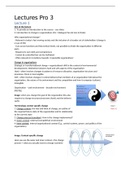College aantekeningen
Project 3 Lecture Notes Everything
- Instelling
- Radboud Universiteit Nijmegen (RU)
This document has all the notes on the lectures of PRO 3; Organizational Analysis. Also guest lecture. The parts that are yellow are not in the Athena Summary.
[Meer zien]




